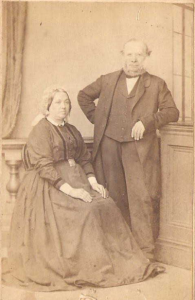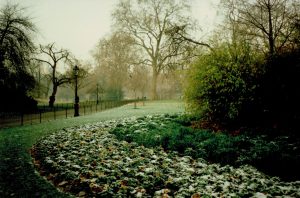8 minute read
I know I am reasonably rare in that I mostly live in the past. Whilst the present and the future are incredibly important and should be focused on, I also see the benefits in venturing to the past from time to time. Sometimes, it is there that our greatest lessons lie or we can find clues to how we should live in the present and make decisions for the future. The past can be a murky place where skeletons rest, only to be disturbed by someone like myself, decades or even centuries later. Peeling back the layers and blowing off the dust on our ancestors can also reveal incredible stories that can inspire us or connect us with the things around us. It can lead us to an unexpected place or allow us to discover something extraordinary.
Back in the 1990s, I took three trips to London. I had been mad keen to go ever since my grandmother Connie spoke of her beloved home city years before. All I really knew about London though, was the usual tourist attractions and some of the places Nan had lived, in East London. I caught up with a work friend, Karen, on my first trip there and she was staying in a hostel run by Irish Catholic nuns, near the Houses of Parliament. Little did I know then how significant the location of St Louise Hostel would become as I delved deeper into my family history, only years later. It would make me ask the question; for those of us seeking them out, do our ancestors guide us and provide clues to their past existence? I’ve had a number of spooky coincidences over the years, including this one I will regale you with today.
On my first trip to London in 1994, I had little idea of Nan Connie’s father’s side; the Duck family. That was an incredible story that would only reveal itself eight years later. So, I was concentrated on her mother’s side; the Drew family. They came from Plymouth to London in the mid-19th century and I was able to confirm some details whilst there, which I brought back to Australia to share with Nan. I enjoyed a second trip to London in 1995 when I worked for a short time. Karen and I would often decide to head to our favourite place, Leicester Square, to see a movie, grab a meal or a one pound coffee. To get there, we had to walk a few streets up towards St James’ tube station, then through St James’ Park; a good 15-20 minute stroll. Many of the buildings on the way have been there since the mid-19th century or longer. I admired them all and would wander around for hours soaking in the atmosphere and the history of the city.
Fast forward to 2001 and a breakthrough led me to find Nan’s father’s first family which opened all sorts of doors when it came to researching that side. To my astonishment, Nan’s father’s parents and grandparents had actually lived in the very area I had lived; in Westminster. Encompassing the area south of St James’ Park and Buckingham Palace, bounded on the left by Victoria Station and on the right by Westminster Abbey, Big Ben and the Houses of Parliament, it is an incredibly historic and affluent part of the city today. Connie’s paternal grandparents were John Thomas Duck and Jane Woodward, who had married in 1864. Their respective fathers, John Duck and Richard Woodward were both listed in various documents as messengers. The Duck and the Woodward families lived only streets apart, the Ducks in slightly better areas than the Woodwards, who resided in an area known as The Devil’s Acre, where slums abounded. I’ll leave their story for another time. It is unknown where Richard Woodward worked but we know from John Thomas and Jane’s marriage certificate that John Duck Senior worked at The Athenaeum Club. John had gone into service at an early age. He was first recorded in the census of 1841, living as a resident of the Pall Mall (check your Monopoly boards), aged 25 and employed as a servant. Two years later he was doing well enough for himself to marry, to a Miss Nancy Prockter, who was also from his native Yorkshire. What prompted John and Nancy to both move to London from their rural Yorkshire towns is as yet unknown but John certainly did well for himself in the city.

Writing at the time of John’s employment at the club, John Timbs described The Athenaeum as like a gentleman’s very own private residence, where a man could do as he pleased, be served by servants without having to spare the expense of having them in his own home, take meals, meet other gentleman and spend time educating himself in the library. It was a club, not for business, but for the higher pleasures of life; to learn about literature, science and the fine arts. In 1850 the cost of joining the club was 25 guineas and the yearly subscription an additional 6 guineas, a fine sum far out of the reach of the ordinary working man, not that they would have been permitted to enter, even if they could find the fee. The Athenaeum Club still exists today but has extended its membership to women as well, in part thanks to John’s own grand-daughters, who took part in the suffragette movement to improve women’s rights. But in John’s world of the mid-19th century, the club was a male only affair. In working at the club, John would have been an attentive servant to the needs of the gentleman members. He would have overheard political conversations, intellectuals chatter about the arts and generally spent his day amongst the top tier of society.
A few weeks ago I started researching for this story and then low and behold, in searching for something to watch on TV one night recently, I came across a UK TV show called Belgravia, set in London in the 19th century. In the third episode, one of its main characters, a working-class man, was able to elevate himself high enough in society to become a member of an exclusive London gentleman’s club. The club featured was The Athenaeum. This was the very same club I had walked past many times, not realising my ancestor had worked there, not for a short time, but for decades, and it was now being presented to me in a way that helped me understand his working life better. In the show, one of the ‘servants’ or employees of the club is seen tut-tutting the main character for breaking the rules of the club when he tries to discuss business with a friend. Perhaps John had to have similar awkward conversations with the newly minted gentlemen of the day, in order to enforce the strict rules of the club. What other duties John would have had as a messenger is not entirely clear to me and warrants further investigation but what is clear from his three decades in service, is that he was a loyal employee and a man who was good at his job and took his responsibilities seriously. John Duck’s devotion to his service meant that he and wife Nancy had a stable home environment in which to bring up their three sons. John Thomas, my ancestor, became a brass finisher. Second son James William found work as a porter, perhaps with help from his father. He died aged only 30. And finally, Henry Harvard went on to become a railway inspector. In August 1877, John grew ill with a urinary complaint and died at St George’s Hospital, aged 65 years. St George’s is also famous for being the hospital featured in the UK TV series, 24 hours in A&E. Nancy would live for another 27 years and be supported by her two surviving sons.
So I ask, is it not extraordinary to think, that I walked the very same path that John Duck did, through St James’ Park, from his home on the south side, to his work at the club on the north side of the park. Of all the places in the huge city of London and all the streets that exist there, how is it I ended up in the same area as my ancestor, long before I knew he had lived there? Connections to our ancestors and to events and places in history are all around us, and can be found with a little research, by asking a few questions and by seeking out the details of the lives of the people who made us.

Should you have further interest in the servant/gentleman dynamic of 19th century London, you can find information and photographs of The Athenaeum Club here:
https://www.athenaeumclub.co.uk/clubhouse/
